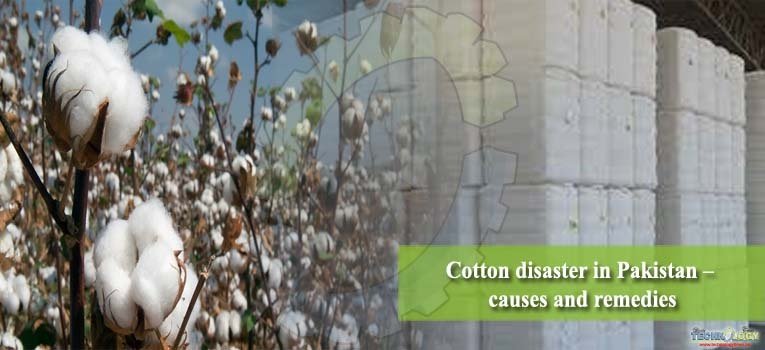Cotton disaster in Pakistan: Agriculture is declared as the backbone of Pakistan’s economy in which cotton contributes the major share. It is often claimed as ‘white gold’ since its silk is used as a raw material in the textile industry.
 Being a highly demanding cash crop, cotton requires more attention in field contrast to others such as sugarcane. Globally, more than 60 countries are growing cotton in which Pakistan ranks 4th and 16th in terms of total production and per acre yield, respectively.
Being a highly demanding cash crop, cotton requires more attention in field contrast to others such as sugarcane. Globally, more than 60 countries are growing cotton in which Pakistan ranks 4th and 16th in terms of total production and per acre yield, respectively.
Punjab province shares approximately 80% of the total national production. At the time of independence, total cotton production in Pakistan was one million bales that gradually increased to 15 million bales in seventy years.
The era of 1984-1992 is referred as ‘‘Magic Years’’ for the cotton production in Pakistan due to tremendous increase in cotton yield. In recent years, only district Vehari produced 1.7 million bales of cotton which was higher than the total share of Sindh province.
Unfortunately, in the past few years, cotton production is badly affected by unfavorable climatic conditions, severe insect attack and poor postharvest management of seed cotton.
Resultantly, the export of cotton and its products has been reduced from 24 billion US dollars to 18 billion US dollars in recent years. In the last few years, cotton remained unsuccessful in fulfilling the national demand leading to collapse of Pakistan’s textile industry.
The cotton plant is delicate and sensitive to changing climate that is rigorously altering the sowing patterns and flowering sequences. Experts are of the view that change in weather conditions has also enhanced the attack of sucking insects in cotton crop.
Unpredicted weather promoted resistance in harmful insects even against resilient Bt varieties. Pink bollworm is also a major factor behind the poor performance of cotton. So, current situation is demanding the introduction of new resistant cotton germplasm.
Ultimately, low cotton yield and growing expenses are pushing farming community to shift to other crops. However, Punjab Agriculture Department has restarted to provide support in terms of guidance and subsidies that have resulted into meeting the required cultivation area target in current year.
There are many other factors which can contribute to regaining good cotton production. Among these, timely sowing, availability of good quality seed, control of insects and diseases, balanced use of fertilizers and timely application of irrigation are the most important.
Recommended varieties should be cultivated and the sowing process must be completed from 15th April to 31st May. It is essential to remove the lint so the seed can pass easily through the sowing drill and reach to required depth where it can attain moisture to germinate. To remove seed lint, it is recommended to use one-liter sulfuric acid for 10 kg of seed.
Prior to sowing, it is necessary to treat the seed with insecticide which reduces the hazards of sucking insects especially white fly against the crop for approximately one month. In case of Bt varieties at least 10% area should be cultivated by non-Bt varieties so the harmful insects can’t attain resistance against Bt varieties. Plant to plant distance should be 9 inches and row to row distance should be maintained at 2.5 feet.
In this way, the required plant population can be obtained i.e. 35000 plants per acre in case of cotton. Important weeds of cotton are deela, it sit, tandla, chibbher, khabbal and madhana. If we maintain the required plant population so there will be lesser space available for weeds to grow.
Earlier 6 to 9 weeks are crucial for cotton regarding weeds. If field remains free of weeds during this duration then yield can be improved. Cotton has moderate irrigation requirements. Excessive rainfall or irrigation is harmful for cotton at any stage.
1st irrigation of cotton sown by drill should be applied after 30 to 35 days. Cotton requires 18 to 20 acre-inches water collectively which can be fulfilled by 5 to 6 times irrigating the crop in case of drill sowing.
All insect pests of cotton hibernate in crop residues, cotton bolls and litter during winter. If they are destroyed during this period, crop can be saved against insects up to a considerable level. It will not only reduce the expenditures of pesticides but increase production as well.
New Bt varieties of cotton sustain for a longer time in the field and give greater yield accordingly balanced use of fertilizers not only maintains soil fertility but also assures good yield. Our farmers are not aware of the timely application, recommended quantity and importance of macro and micronutrients so they are not able to get benefit with the application of these nutrients.
There should be a gap of 15 to 20 days in cotton picking. Early picking results in un-ripened silk. Cotton picking should start at 10 am so the lint will be free of moisture. Dried lint doesn’t lose its color and quality.
With the improvement of cotton crop production, the agriculture sector will contribute to the country’s economy and eventually results in the prosperity of the nation.
This can be achieved with the mutual cooperation of the agriculture department and farmer community through adopting improved agronomic practices, wise use of agricultural inputs and shifting to advanced technology.